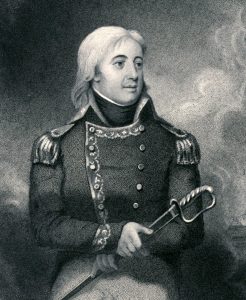One of the most colorful men to seek and earn an officer’s commission in the Continental Navy was Joshua Barney. He was a man with little formal education or military experience; a mariner who had natural gifts of seamanship, leadership, and courage. Barney took part in thirty-five Revolutionary War naval engagements and lost only five of these encounters. He suffered imprisonment three times, but escaped twice by using clever disguises. He was shipwrecked twice and put down a mutiny. Barney’s impressive sea victories, frustrating setbacks and cleverness as a prisoner of war constitute a remarkable series of events.
Joshua Barney was born on July 6, 1759 to an upper middle class family near Baltimore, Maryland. Each of his parents, William and Frances Barney, had inherited considerable farmland holdings. He was raised near Bear Creek on Patapsco Neck as one of fourteen children. The seaports along Chesapeake Bay had just begun to rise in prominence and shipbuilding emerged as an important industry. The family farmhouse was near one of the many inlets for the small boats that plied the Patapsco River. Electing the life of a sailor, young Joshua Barney signed on as a hand aboard a Chesapeake pilot schooner to learn the rudiments of seamanship in 1771.

Barney went on to serve with distinction as a junior officer in the Continental Navy during the Revolutionary War. After a few triumphs and many defeats against Britain’s daunting and disciplined navy, by the spring of 1782 America’s Continental Navy was decimated. It was modest to begin with and now it was down to only two frigates, the Deane and the Alliance plus half a dozen smaller vessels.[1] Barney, having seen a great deal of combat and the inside of several British prisons, now assessed his prospects for a career in the Continental Navy. Because the list of unassigned naval officers numbered twenty-two captains and thirty-nine lieutenants, the likelihood of finding a billet appeared slim. Daniel Smith, secretary to the Pennsylvania Commissioners for the Defense of the Delaware, was aware of Barney’s availability and offered him the commission of captain in the Pennsylvania Navy and command of a ship of his own. A Pennsylvania commission, though not a Continental Navy rank, might prove to be a quicker route to a Continental Navy captaincy.
The Pennsylvania Navy purchased and armed the 100-ton merchantman Hyder-Ally and the twenty-two-year-old Barney assumed direction of her conversion into a warship.[2] The vessel was named for Hyder-Ally (also spelled Haidar Ali) who led a courageous, but unsuccessful 1781 revolt against the British in India. The elapsed time from Barney’s appointment as captain to finishing the recruiting and rudimentary training of the approximately 100-man crew and the ship’s refitting was an astonishing fourteen days, a testament to his leadership abilities. He cast off on April 7, 1782 to await any enemy that was likely to appear in the Delaware Bay. [3]

The Marine Committee of Pennsylvania ordered Barney to escort a convoy of seven merchant ships including the Charming Sally and General Greene to the mouth of the Delaware and out to sea. At sundown the wind died and the convoy was forced to anchor in sheltered water inside Capes May and Henlopen. Out in the Atlantic, the British frigate Quebec, the sloop-of-war General Monk and the brig Fair American cruised between the capes at the mouth of the Delaware with the Quebec patrolling a few miles out to sea beyond the capes in order to interdict any escaping American shipping.
The next morning Barney’s lookout noticed that three ships were approaching the Hyder-Ally and the convoy. He ordered all vessels to weigh anchor, return up the channel and stay as close to the shore as possible. The British warships were unlikely to follow in shallow, poorly-charted water. The Hyder-Ally would act as their rearguard protector.
The tight throng of American ships weighed anchors and set sail. In its haste, the merchantman Charming Sally ran aground on the Overfalls Shoal and became a potential British prize. The General Greene, armed with twelve guns, disobeyed Barney’s order to leave and opted to fight alongside the Hyder-Ally. Usually obstinate, Barney did not object, perhaps reasoning that the battle was now between two Americans ships against two British vessels. Barney had his crew throw overboard any heavy unneeded equipment in order to lighten the Hyder-Ally. The two American vessels tacked back and forth in order to present a tempting target for the approaching enemy in shoal water while covering for the remainder of the departing merchant fleet.
The British privateer Fair American led the General Monk into the engagement with the Americans. The General Greene abruptly changed course to avoid disadvantageous contact, but the quarters were too tight and she ran aground off Cape May Point. The Fair American sailed past the stranded General Greene to pursue the fleeing convoy of potentially richer prizes. Evidently it was thought that the General Greene could be dealt with later. Now Barney’s defensive strategy of sailing close to the shore worked. The Fair American buried its keel into the muddy flats, taking her out of action. The impending battle now had one British and two American vessels aground on various shallows near the mouth of Delaware Bay.
The eighteen-gun General Monk and the sixteen-gun Hyder-Ally initially exchanged ineffectual shots from afar. Then they maneuvered alongside each other to trade damaging broadsides. During the thunderous exchange of fire, the two ships drifted within earshot of each other. Barney then told his helmsman to follow his next orders, but by “the rule of the contrary”—that is do the opposite of the command that is given. Patiently watching for the right moment when the Hyder-Ally had about a third of a boat length lead on the General Monk, Barney bellowed a command to his helmsman at the top of his lungs to turn to port. This purposeful order was easily heard on the General Monk and her captain ordered the helmsman to cover this tack. The Hyder-Ally, however, abruptly turned to starboard as the Monk turned to port and the jib boom of the latter became tangled in Hyder-Ally’s rigging. As the battle progressed, Barney climbed upon the wooden binnacle to direct the fighting through his speaking trumpet. In a shower of splinters, the binnacle was shot away from under him, but Barney escaped serious injury. He then ordered deckhands to secure the British ship’s jib spar to the American’s rigging, preventing the Monk from backing away. Barney commanded his gunners to fire a broadside of pre-loaded grapeshot in order to wound as many of the British gun crews as they could. The grapeshot also caused the British sloop-of-war’s canvas, rigging and yards to fall heavily onto the General Monk’s deck. Barney’s men then boarded and fought through the debris of cordage and broken spars.
After about twenty-six minutes, the one-sided conflict ended. Barney had seized the General Monk. Barney had to anticipate engaging the Quebec that was only a league, three nautical miles, away. The Hyder-Ally was damaged but could still be sailed under control. To deceive the Quebec into thinking that the British had won the battle, Barney ordered the Royal Union standard raised aloft on both ships. A crewman found a copy of the British signal book in the General Monk’s cabin. Barney cunningly signaled that they were successful in their battle and was able to correctly answer signals from the distant Quebec. To continue the ruse, Barney had the Hyder-Ally tied to the stern of the General Monk, much like the British would have expected for a prize ship. The captain of the Quebec evidently assumed that the General Monk was going to apprehend any stragglers in the American merchant ship convoy and elected to stay on his blockade station at the mouth of the Delaware.
Before the day ended, Barney started for home and overtook six members of his convoy now safely anchored further up the bay. Leaving the smaller Hyder-Ally anchored among his mostly intact merchantmen convoy off Chester, Barney sailed his prize, the General Monk, back to the port of Philadelphia. A thirteen-gun salute and a swelling crowd of well-wishers gathered at the dock announced his arrival.[4]
This late Revolutionary War battle was one of the very few decisive American naval victories against a stronger foe, both in number of vessels and in weight of cannon shot. It gave the United States a sorely needed act of heroism and victory in which to display military pride. The State of Pennsylvania awarded Barney a presentation sword as an expression of gratitude for valor, which became a great source of personal pride.[5] Perhaps because this incident occurred subsequent to the more historic Battle of Yorktown, and it was a state rather than a Continental Navy victory, it is not well remembered today.
The Pennsylvania Navy repaired the General Monk and changed her name to the General Washington, the ship’s identity before the British captured her two years earlier from Silas Talbot. Joshua Barney was ordered to use the ship for the defense of the Delaware as a letter of marque eighteen-gun warship of 250-ton burden carrying 120 men.
During the summer of 1782, the war wound down and raids on the Delaware were less of a problem. The Pennsylvania Commission, in need of money, sold the General Washington to the Continental Navy for use as a dispatch vessel. Barney returned to Continental Navy service as her commander, at the time still holding the rank of lieutenant.[6]
Barney was ordered to France to ferry French and American personnel and documents needed for the impending end to hostilities. By chance, Barney carried the news that the provisional peace treaty had been signed on November 30, 1782, news that had taken about two months to cross the Atlantic. On April 16, 1783 Admiral Count d’Estaing reported the official signing of the Treaty of Paris to the general population in Philadelphia.
When Barney retired from active naval service, he received a touching letter from Henry Laurens that stated, “Your discharge from the service of the public, an act of necessity and with your own approbation, cannot obliterate the honor you acquired, nor wither the laurels which you gained in that service. The ploughshare now is preferable to the spear. You are on shore making a better provision for your progeny . . . I am persuaded that you could not remain a day unemployed.”[7] Laurens was prophetic; Joshua Barney became a successful business man, a captain in the French Navy, a commodore in the nascent United States Navy, and a hero of the War of 1812.
[1]The Alliance was first commanded by the enigmatic Pierre Landais and later under the legendary John Paul Jones.
[2]Beginning in 1775 after the start of the Revolutionary War, eleven of the thirteen colonies established state navies or owned one or more armed vessels.
[3]The Pennsylvania legislature did not officially pass the resolution authorizing the purchase of Hyder-Ally for the defense of the Delaware until April 9, 1782. Thus, it was not the property of the commonwealth when it won its most famous battle.
[4]This was an ironic meeting of three of the ships that took part in the battle. They were formerly commanded by three well-known Continental Navy captains during the Revolutionary War, Dudley Saltonstall, John Manley, and Silas Talbot.
[5]Unfortunately, this sword was later stolen in Paris. Barney prized it so much that he had a duplicate made.
[6]Although Barney was addressed as captain, his Continental Navy promotion from lieutenant to captain did not come until March 6, 1784, after the war had officially ended.
[7]Mary Barney, ed., Biographical Memoir of the late Joshua Barney. From Autobiographical notes and Journals in Possession of His Family, and other Authentic Sources (Boston: Gray and Bowen, 1832), 150-51.








One thought on “Joshua Barney, the Hyder-Ally‘s Triumph, and its Aftermath”
I enjoyed reading about Joshua Barney. He, as much as anyone, secured American Independence.